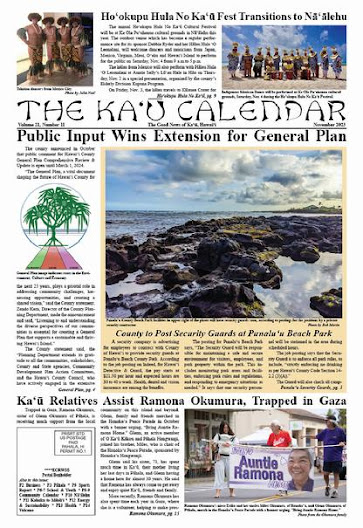 |
| Lisa Louise Adams is one of the artists hosting the studio tour of Volcano Village Artists Hui this Friday, Saturday and Sunday weekend. See volcanovillageartistshui.com Image by Lisa Louise Adams |
A STATEMENT ON THE RELEASE OF AMERICAN AND ISRAELI HOSTAGES CAME ON Wednesday, Thanksgiving Eve, from Sen. Mazie Hirono. A member of the Senate Armed Services Committee and Chair of the Subcommittee on Readiness and Management Support, Hirono addressed Israel and Hamas agreeing to a four-day humanitarian pause in violence in order to facilitate the release of 50 hostages held by Hamas and allow for humanitarian aid to help
Palestinian civilians in Gaza.
 |
| volcanovillageartistshui.com |
Hirono said, “I welcome this agreement to allow for the release of American and Israeli hostages being cruelly and unjustly held by Hamas. This humanitarian pause will enable the flow of critical aid and supplies into Gaza and I commend President Biden and his team for their determination in facilitating this agreement. My thoughts are with all of the people and families who have endured this horrific violence. We must continue working to reunite all of the hostages with their families, secure humanitarian aid for innocent civilians in Gaza, and determine a way to achieve a two-state solution and facilitate peace in the region. ”
Last month, Hirono joined a group of her Senate colleagues in calling for humanitarian pauses and hostage releases in the Israel-Hamas war.
Some 1,200 people were killed and 240 others taken hostage by Hamas during its October 7 attack on a festival and surrounding villages in Israel. According to health officials in Hamas-ruled Gaza, more than 11,000 Palestinians have been killed by Israel's invasion by air and ground.
To read comments, add your own, and like this story, see facebook.com/kaucalendar. See latest print edition at kaucalendar.com, in the mail and on stands.
A VENDING STAND LOCATION IS UP FOR BID AT COOPER CENTER IN VOLCANO VILLAGE. County of Hawai‘i Department of Parks & Recreation invites mobile vending stand operators to submit bids for lease concessions to operate at Cooper Center in Volcano, Onekahakaha Beach Park and Reed's Bay Beach Park in Hilo, Isaac Kepo‘okalani Hale Beach Park in Puna and Kailua Park (Old Airport) in Kailua-Kona. The Volcano location at Cooper Center is just off Wright Road.
Prospective bidders must file a notice of intent to bid on or before Nov. 27 to the Director of Finance on a form provided by the Director through Public Purchase at www.publicpurchase.com, an e-procurement system.
Sealed tenders will be received electronically and publicly opened at 2 p.m., Monday, Dec. 11, in the Office of the Purchasing Division, Department of Finance, County of Hawaiʻi, 25 Aupuni Street, Hilo, Hawaiʻi.
To read comments, add your own, and like this story, see facebook.com/kaucalendar. See latest print edition at kaucalendar.com, in the mail and on stands.
 |
| Chain of Craters Road, Devastation Trail and parking and coastal backcountry sites have reopened. NPS photo |
REOPENING OF CHAIN OF CRATERS ROAD, including coastal backcountry sites, Kulanaokuaiki Campground, Keanakākoʻi, and the Devastation Trail and parking was announced by Hawai‘i Volcanoes National Park on Wednesday morning.
USGS Hawaiian Volcano Observatory scientists and park staff closely monitored a flurry of earthquakes that shook the ERZ near Puhimau Crater in the park on Tuesday. The activity, which decreased through the night, prompted park closures that were lifted Wednesday morning as unrest and seismicity returned to normal levels in Kīlauea volcano's upper East Rift Zone (ERZ).
According to USGS, the "brief seismic crisis" in the upper ERZ has subsided, greatly reducing any chance of eruptive activity in that area. There is currently no sign of an imminent eruption in this area, according to USGS.
Seismic activity has returned to the pattern held since mid-October with the unrest focused in an area south/southwest of the caldera to the Koaʻe fault zone. As a precaution, two trails to the south/southwest of the caldera closed since October remain closed.
Park visitors should go to the park website for updates and alerts that could impact their visit, said the statement from the Park.
To read comments, add your own, and like this story, see facebook.com/kaucalendar. See latest print edition at kaucalendar.com, in the mail and on stands.
 |
| Specialized protective training and equipment, working in teams and careful oversight of missions go into the safety of geologists at Hawaiian Volcano Observatory. USGS photo |
VOLCANO MONITORING IS RISKY BUSINESS. Volcano Watch, the weekly column by USGS Hawaiian Volcano Observatory scientists and affiliates, discusses how the work can be done safely: Active volcanoes are inherently hazardous places to work. Even when a volcano is quiet, volcanic gases, ground cracks, earthquakes, and uneven surfaces can be unsafe. Advanced planning and preparation for fieldwork in these environments is critical to reducing the personal risk of volcanic hazards to field crews.
At HVO, fieldwork is critical for monitoring and understanding volcanoes. All the time spent in the field exposes staff to many potential hazards, whether or not they are working in areas near active eruptions. Staying safe while performing mission-critical work is our main priority.
Most of HVO's field sites are more than one hour from definitive medical care, so staff take Wilderness First Aid training which prepares them for a variety of injuries and illnesses. Heat-related illnesses, hypothermia, and altitude sickness are major concerns with the wide range of environments on Hawaiian volcanoes from sea level to over 13,000 ft (3,960 meters) elevation.
When working in hazardous conditions fieldwork typically includes at least two people for situational awareness, to decrease the amount of time needed to complete a task in potentially dangerous conditions and to help a field partner in case of injury or illness. Each crewmember carries at least two modes of communication just in case there is no service or the device batteries are depleted. Commonly used communication devices include cell phones, radios, satellite messaging devices, and satellite phones.
 |
| HVO scientist clears tephra from a solar panel during the September 2021 Kīlauea summit eruption. A glove is used to brush away Pele's hair and other fine volcanic glass fragments to avoid small cuts and splinters. While working within the closed high-hazard area at Kīlauea summit within Hawaiʻi Volcanoes National Park, hardhats are used to protect the wearer from falling tephra. Gas masks are worn around the neck for quick protection if volcanic gas concentrations escalate or the wind shifts suddenly, even during non-eruptive periods. HVO access to the closed area is by permission from, and in coordination with, HVNP. USGS photo. |
Before fieldwork starts, the crew will discuss the work that needs to be done, identify any potential hazards that may be encountered, and what can be done to mitigate those hazards. For example, if a crew is dropped off at a remote site by helicopter, they will bring extra food and water along with overnight gear in case weather conditions prevent the helicopter from extracting them.
Each field crew designates a point of contact (POC). The crew will check in with the POC before beginning fieldwork, and again when they end for the day. The POC will communicate any relevant information to field parties, including significant changes in monitoring data and weather that might warrant an immediate cancellation of fieldwork. In extreme cases, the POC will initiate search and rescue procedures if the crew fails to check out or cannot be reached.
We avoid working in high-hazard locations whenever possible, but sometimes field crews need to access these areas for mission-critical work. When this is the case, additional safety precautions are taken. Hazardous areas, such as the closed areas of Hawaiʻi Volcanoes National Park are only accessed by essential crews who carry personal protective equipment with them. Common PPE used in the field by HVO staff includes respirators to filter volcanic gases, gas badges to monitor SO2 concentrations, along with helmets and eye protection. When molten lava sampling, each crewmember will carry a face shield, fire-resistant clothing, and gloves to protect the wearer from radiating heat. HVO access to the closed area is by permission from, and in coordination with, HVNP.
 |
| Many hazards challenge USGS Hawaiian Volcano Observatory scientists. USGS photo |
Numerous other hazards can be encountered on volcanoes in Hawai‘i. Earthquakes can occur without warning and increase the hazard of rockfalls, ground cracking, and cliff instability, especially around the rim of Halema‘uma‘u crater at the summit of Kīlauea.
Even seemingly benign environments have associated hazards. For example, the surfaces of lava flows, even ones that are decades old, are uneven and sharp. They can be difficult to walk on, with tripping hazards and the possibility of lacerations if you fall. There are many sub-surface void spaces below seemingly solid ground, which can cause injuries such as ankle sprains or cuts if you break through. Volcanic gas levels can also remain hazardous near vents even after an eruption has ceased. When visiting HVNP it's important to stay on marked trails and not enter any closed areas.
Visiting Hawai'i's volcanoes is an awe-inspiring experience, but it can also be a hazardous one if you aren't careful. HVO staff are aware and prepared; you, too, should stay informed and be familiar with volcanic hazards and HVNP safety tips before hitting the trails.
To read comments, add your own, and like this story, see facebook.com/kaucalendar. See latest print edition at kaucalendar.com, in the mail and on stands.



.JPG)




.png)